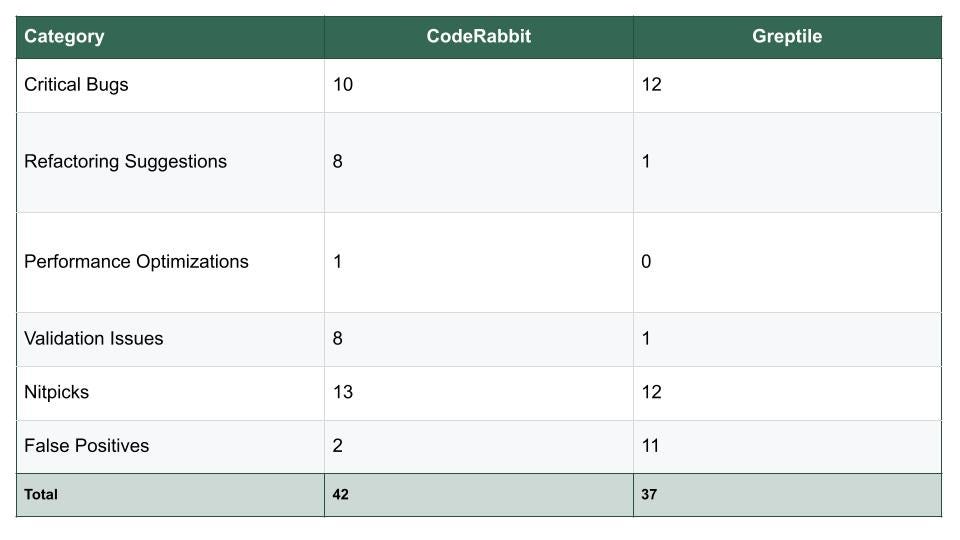Artificial intelligence is transforming software development. Tools like GitHub Copilot act as an AI coder to assist developers by generating code snippets, while dedicated AI code review tools such as CodeRabbit and Greptile analyze pull requests (PRs) and suggest improvements.
These AI tools aim to improve pull request reviews and embed into best practices for enterprise CI/CD pipelines, catching bugs early and speeding up releases. Below we compare CodeRabbit and Greptile on key metrics like bug detection and comment quality, using recent benchmark data and analysis.

Evaluation Setup and Categories
In a recent independent evaluation, real open-source PRs were reviewed by both CodeRabbit and Greptile under the same conditions. Comments from each tool were categorized into types engineers care about:
- Critical Bugs: Severe defects (e.g. a SQL injection) that break functionality or security.
- Refactoring: Suggestions to improve code structure or remove duplication.
- Performance Optimization: Ideas to make code faster or use less memory.
- Validation: Checking logic and edge cases (e.g. verifying API error handling).
- Nitpicks: Minor style/format fixes.
- False Positives: Incorrect flags where the code is actually fine.
These categories help assess not just how many issues each tool catches, but the signal-to-noise ratio of their feedback (engineers prefer high-value comments over trivial nits).
Comparative Results

The benchmark revealed notable differences between CodeRabbit and Greptile:
Key Observations
1. Critical Bug Detection
Greptile slightly edged out CodeRabbit in catching critical bugs (12 vs. 10). While both detected major issues that could cause runtime failures or severe security risks, Greptile’s marginal lead suggests a stronger focus on high-severity vulnerabilities.
2. Code Improvement Suggestions
CodeRabbit clearly outperformed Greptile in refactoring recommendations (8 vs. 1) and validation issues (8 vs. 1). This shows CodeRabbit is more proactive about long-term maintainability and ensuring code changes meet intended requirements.
3. Performance Optimization
Only CodeRabbit flagged performance-related issues (1 vs. 0). While the number is small, these optimizations can be impactful in high-scale environments.
4. Noise and False Positives
False positives — feedback that’s incorrect or irrelevant — can slow down teams. Greptile had a much higher count here (11 vs. 2 for CodeRabbit), suggesting CodeRabbit produces cleaner, more actionable reviews.
These findings can be summarized as:
- Bug Catch: Greptile 76% vs. CodeRabbit 82%
- Comments/Noise: Greptile High vs. CodeRabbit Moderate
- Feedback Quality: Both high (good clarity and actionable comments)
- PR Summary: Both Excellent
- Avg. Wait Time: Greptile ~288s, CodeRabbit ~206s
These metrics help explain how each tool would fit into a development workflow. Greptile’s strength is in maximum bug detection — it flags the most issues (critical bugs, security flaws, etc.). CodeRabbit, on the other hand, provides slightly faster, more streamlined reviews with fewer low-value comments.
Improving PR Reviews & CI/CD
AI-assisted reviews like CodeRabbit or Greptile embody best practices for modern CI/CD. By integrating an AI code review tool into the pipeline, teams can improve pull request reviews by catching errors automatically before code is merged. This follows enterprise CI/CD best practices: automated analysis and PR checks help maintain code quality at scale. Research shows manual reviews alone often slow teams down and miss issues that machines can catch quickly. Automating PR reviews with smart tools accelerates development: reviewers focus on high-level design, while the AI handles routine checks.
For teams looking to buy an AI code review tool, these benchmarks offer guidance. Key factors include bug coverage (how many real bugs are caught) and signal-to-noise ratio (how many suggestions are actually useful). For example, one test found Greptile caught nearly every critical bug, whereas CodeRabbit missed more but produced fewer extraneous alerts. In practice, teams prioritizing strict bug-detection (e.g. security) may lean toward Greptile, while teams valuing brevity and speed might favor CodeRabbit. In either case, using an AI reviewer helps follow best practices: every PR is automatically checked, nothing slips through, and developers spend time reviewing or merging rather than hunting for typos or minor issues.
Conclusion and Recommendations
In summary, both CodeRabbit and Greptile are among the best AI code review tools for modern development. Greptile excelled at bug detection, catching 82% of test issues vs. CodeRabbit’s 44%. CodeRabbit, however, generated fewer superfluous comments, aiming to cut review “noise” and speed up feedback. Both provide high-quality, actionable feedback and excellent PR summaries.
If you need maximum bug detection, Greptile performs best. Teams seeking leaner reviews and faster turnaround might consider CodeRabbit. The choice depends on your team’s needs: more thorough catching (Greptile) versus leaner reviews (CodeRabbit). For example, a security-critical team might tolerate extra comments in exchange for catching every flaw, while a fast-moving agile team might prefer a “lighter” reviewer.
In either case, both tools embody programming AI applied to code quality, fitting into enterprise CI/CD workflows. Adopting such an AI code review agent is a proven way to improve pull request reviews and maintain high code standards. Teams planning to invest in an AI review solution should weigh these trade-offs — using data-driven benchmarks like those above to choose the tool best aligned with their priorities.






